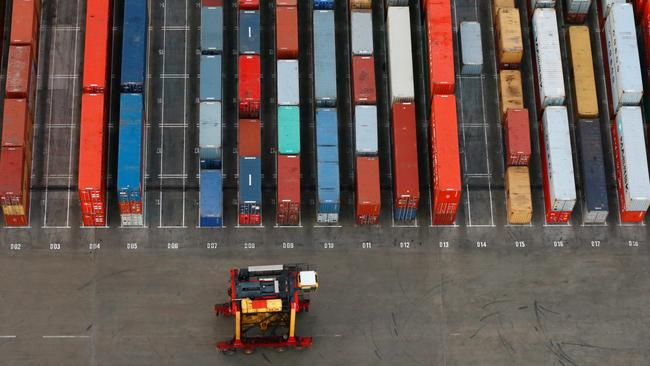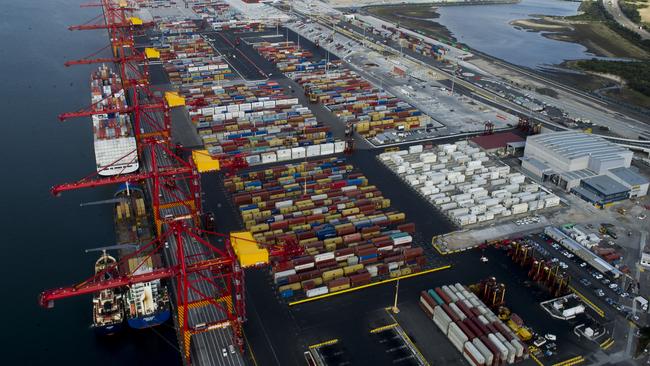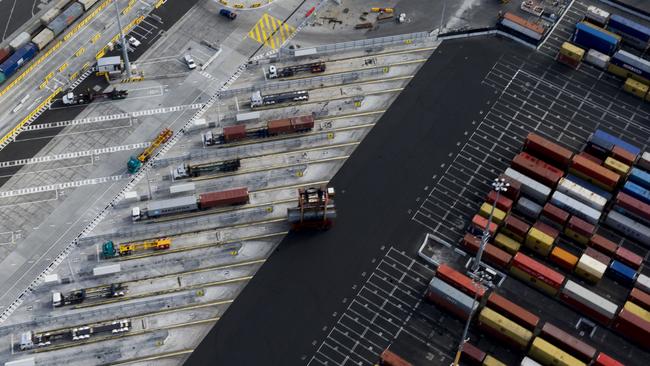
Dozens of the nation’s biggest port users from miners, grain exporters, steel makers and key importers from builders to food producers have hit out at the dysfunction in ports which is adding to higher prices and undermining the nation’s recovery from the Covid pandemic.
A cache of submissions have been released as part of an official probe into the nation’s waterfront by the Productivity Commission ordered by Treasurer Josh Frydenberg in December.
The inquiry is investigating surging costs and supply chain freezes brought about by the pandemic and follows last year’s landmark Australian Competition and Consumer Commission investigation into the waterfront which rated the nation’s biggest ports among the worst performing in the world.
Major problems in ports and logistics were “feeding into the cost of imported goods, which adversely impacts the standard of living for all Australians”, supermarket operator Metcash said in its submission to the Productivity Commission.
“Delays caused by outdated industrial, quarantine and custom practices … are obvious candidates for reform to improve efficiency and reduce costs in the maritime logistics system.”
More than 65 industry groups, port operators and state governments have urged the Productivity Commission to help untangle the issues slowing throughput at ports, arguing the problems are undermining the nation’s growth. The probe is due to release a draft report in May.

The Business Council said port customers often lacked visibility as to what was happening with their imports while also being hit with skyrocketing costs.
“While they pay for a service, it can still take days to get access to their container out of a port. Further, with enterprise bargaining negotiations continuing at some ports and with some stevedores, industrial actions are ongoing, and it is not clear when they will come to a head”.
The BCA warned industrial relation tensions “appear to be compounding” the issues on the nation’s waterfront.
“Rather than extended strike action, industrial delays appear to be occurring due to reduced hours and artificial limits on productivity,” the BCA said.
The Housing Industry Association, called for both the ACCC and the powerful building and construction commission to hold “joint powers” to deal with competition and industrial issues at Australia’s ports.
Others took aim at surging port access costs introduced by stevedores, with the NSW government saying it was often asked to intervene over surging fees imposed on freight-forwarders, cargo owners and transport companies.
“It is expected the stevedore charges are adding to the costs of shipping for exports and importers, with productivity implications for businesses and consumers,” the NSW government said in its submission.
‘Uncompetitive’
The nation’s ports are dominated by three stevedores: DP World Australia, Patrick Terminals and Hutchison Ports. Each asked for their submissions to the inquiry to remain confidential.
Others argued the fragmented operational structure of the ports meant that no single operator was driving efficiency or productivity across all parts of the waterfront. It also meant cost savings made in one area could be eroded away.
“Without intervention, Australia’s maritime logistics system is likely to continue functioning in a manner which leaves businesses vulnerable to uncompetitive prices and contractual terms further exacerbating Australia’s supply chain crisis,” the Australian Industry Group warned.
Transport links also came under focus, with poor rail links slowing the ability for containers to be moved efficiently from ports. Sydney’s Port Botany was identified as being serviced by the most congested road network.
Food manufacturers also hit out at a surge in prices to access ports and said waterfront strikes had “led to significant anxiety and stress” for business operators
“The underlying market problem associated with Australia’s maritime logistics system has medium to long term implications for the competitiveness, resilience, and risks local food and grocery manufacturing presence in Australia,” the Australian Food and Grocery Council said.
The AFGC said it had received feedback of missed shipping windows which had led to a loss of business and product wastage.
The Minerals Council acknowledged congestion at major ports outside Australia and a global container and pallet shortage was behind many pressures, but it urged greater regulation of stevedore charging practices.
It also called for “incremental workplace relations reforms” including narrowing the scope of protected industrial action for port workers.

The MCA said port disruption over the past year has delivered challenges including causing delays in mining projects and cost overruns in importing machinery.
“The lead time to order haul trucks from a supplier increased to 15 months with cost increases of 12 to 15 per cent,” the MCA said
Peter van Duijn of Deakin University’s Centre for Regional and Rural Futures, noted port privatisation had led to increases in property costs for stevedores, which in turn had prompted terminal access charges.
The Grain Growers association noted export costs had skyrocketed in the past three years. Exporting grains to India had increased from $US30 tonne on average to $US120 a tonne.
“The cost to the grains industry has been amplified by inefficiencies and underperformance of our ports and landside freight networks,” Grain Growers said in its submission.
“Further work needs to be done…to better understand these costs, including understanding the extent to which prices will recover to a more reasonable level post-pandemic,” it said.
Paddy Crumlin, the national secretary of the Maritime Union of Australia, said if the Productivity Commission focused its attention on industrial relations “it will miss other more significant issues” that need attention.
The MUA said consolidation of shipping lines and cargo alliances meant that 75 per cent of ships entering the ports were late, addingfreight costs for ships between Australia, China and Europe have soared.
The bigger challenge facing supply chains was a reliance on international shipping, “which is not regulated and is exempted from the normal competition laws that applies to other businesses in Australia”, the MUA said.
johnstone@theaustralian.com.au




The nation’s ports are close to breaking point with surging stevedoring charges, rising union power and poor transport links, adding to business costs and fuelling inflation.